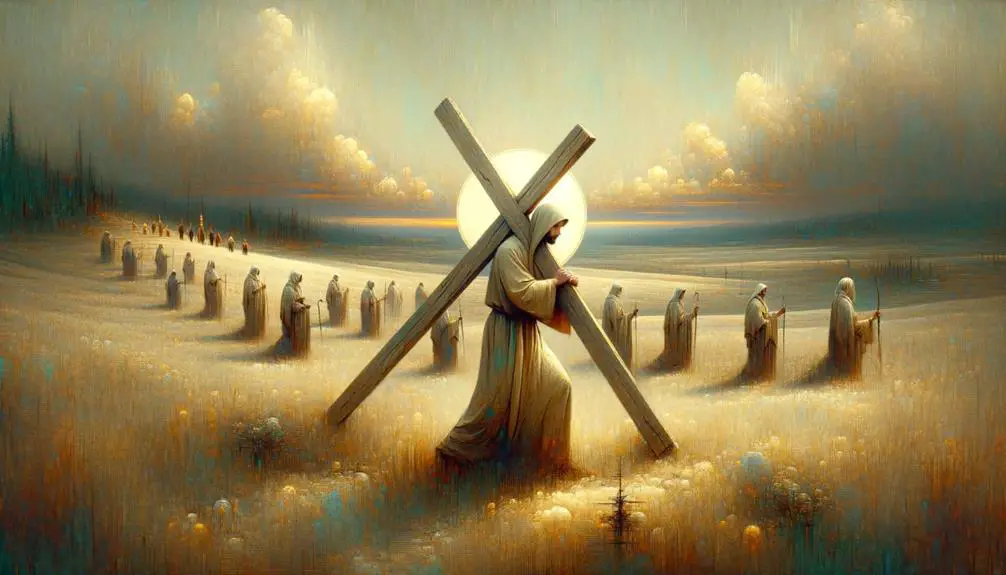Explore the multifaceted roles of Simon in the Bible, from apostle to antagonist, and the profound lessons they offer for our lives.

Who Is Simon in the Bible
In the tapestry of biblical narratives, the name Simon weaves through with both reverence and infamy, a testament to the complexity of human character. You'll find Simon Peter, hailed as the rock upon which a church was built, standing shoulder to shoulder with Simon the Sorcerer, whose quest for power reveals the darker facets of ambition.
But, who exactly were these Simons? Each carried a story, a lesson tailored for the ages, beckoning you to explore the depths of their journeys. Uncover the threads that bind them, and you might just find a reflection of humanity's unending quest for meaning and redemption.
Key Takeaways
- The Bible mentions multiple Simons, each with distinct roles and stories, from apostles to individuals encountering Jesus.
- Simon Peter is notable for his leadership in the early Christian church and represents the complexities of faith and forgiveness.
- Simon the Zealot and Simon of Cyrene symbolize resistance and sacrifice, intertwining political and spiritual narratives.
- Simon the Pharisee and others like Simon the Leper or Simon the Sorcerer show the diverse interactions and transformations around Jesus' teachings.
Simon Peter: The Rock

Simon Peter, often considered the bedrock of the early Christian church, showcases a complex interplay of faith, leadership, and human frailty throughout biblical narratives. His journey, marked by moments of profound faith and occasional lapses, offers a nuanced understanding of Apostolic leadership. Peter's faith, initially wavering as seen when he doubted Jesus's ability to protect him on water, eventually solidifies, becoming the cornerstone of his leadership role among the Apostles. This transition isn't merely a testament to his personal growth but also underscores the transformative power of faith and forgiveness in Christian doctrine.
Peter's role in the early church can't be understated. His Apostolic leadership, characterized by bold proclamations of faith and decisive actions, set a precedent for the spreading of the Christian message. Despite his failings, such as the denial of Jesus, Peter's journey is emblematic of redemption and unwavering commitment to his calling. This duality of Peter—both flawed and faithful—renders him a relatable figure, embodying the complexities of spiritual leadership.
Analyzing Peter's trajectory from a fisherman to a foundational figure in Christianity reveals the critical role of faith in guiding Apostolic leadership. His story is a compelling narrative of resilience, showcasing how personal shortcomings can be overcome through faith and determination. Peter's legacy, therefore, isn't just in his establishment of the church but in his embodiment of the human struggle to maintain faith amidst trials. Through his life, believers are offered a model of how to navigate the challenges of leadership and faith.
Simon the Zealot: The Revolutionary
You may find it intriguing to explore the Zealot movement's origins, which serves as a backdrop to understand Simon's revolutionary role. This movement, characterized by its fervent resistance against Roman occupation, provides a critical context to appreciate Simon's dedication and actions.
Zealot Movement Origins
To understand the origins of the Zealot movement, it's crucial to delve into the socio-political turmoil of 1st-century Judea, where grassroots resistance against Roman oppression gave rise to figures like Simon the Zealot. This period was marked by a seething cauldron of political motivations, as Judeans sought to reclaim autonomy from Roman rule.
The social impact of this struggle was profound, igniting a fervent desire for liberation among the people. The Zealots emerged as a radical faction, advocating for a violent overthrow of the Roman authorities. Their philosophy was deeply intertwined with Jewish religious beliefs, viewing their fight as not only a political struggle but a divine mandate.
Simon the Zealot's alignment with this movement highlights the intricate connection between faith, politics, and the quest for social justice in ancient Judea.
Simon's Revolutionary Role
Against the backdrop of the Zealot movement's emergence, Simon the Zealot carved out a distinctive role as a revolutionary, challenging Roman authority with a fervor matched by few. Here's how he left an indelible mark:
- Simon's identity: Steeped in zealotry, his persona symbolized resistance, advocating for Jewish sovereignty against Roman occupation.
- Strategic mobilization: He utilized grassroots organization to galvanize support, leveraging social ties for revolutionary purposes.
- Apostolic legacy: Post-resurrection, Simon's fervor was redirected towards spreading Jesus' teachings, embedding revolutionary zeal within Christian evangelism.
- Symbolic defiance: His life stood as a testament to the possibility of transformation, from insurgent to apostle, without losing the essence of resistance.
In analyzing Simon's revolutionary role, you uncover a complex figure, intertwining political rebellion with spiritual awakening.
Simon of Cyrene: The Bearer

Simon of Cyrene, compelled by Roman soldiers, played a pivotal role in the Christian narrative by carrying Jesus' cross on the way to Golgotha. This act, though brief within the broader scriptural texts, carries deep symbolic weight and highlights Cyrene's significance in the ancient world. Cyrene, a city in modern-day Libya, was then a prominent hub of culture and commerce, suggesting that Simon wasn't a mere passerby but a man of some standing, involuntarily drawn into history's most transformative event.
The symbolism of the cross, central to Christian faith, represents sacrifice, redemption, and the intersection of divine and human suffering. Simon's act of bearing the cross, even under coercion, embodies a shared burden, inadvertently aligning him with Jesus' mission of salvation. This moment, captured in scripture, transcends its historical context, inviting believers to reflect on themes of compulsion, service, and the profound mystery of divine providence.
Scholarly analysis of this encounter sheds light on the dynamics of power, submission, and identity in ancient Roman society. The compelling of a civilian by Roman soldiers underscores the oppressive weight of empire, yet it also foreshadows the subversion of that power through the cross's ultimate significance. Simon of Cyrene's forced participation becomes, paradoxically, a moment of grace—a point of contact between the mundane and the miraculous.
Understanding Simon's role requires grappling with the cross's dual nature as a symbol of both brutal execution and transcendent hope. His story, embedded within the Passion narrative, challenges readers to consider the complexities of faith, obedience, and the unexpected ways in which salvation history unfolds.
Simon the Pharisee: The Host
You'll find that Simon the Pharisee's dinner invitation to Jesus sets a significant scene in the New Testament, offering a rich tapestry for understanding social and religious dynamics of the time.
Jesus' response to Simon, marked by parables and teachings, reveals deep insights into forgiveness, humility, and divine grace.
Analyzing Simon's story, you uncover layers of meaning about societal norms, personal transformation, and the essence of spiritual enlightenment.
Simon's Dinner Invitation
In a notable episode from the New Testament, a Pharisee named Simon extended an invitation to Jesus, setting the stage for an event rich in theological and social implications. This dinner invitation isn't just a casual meal; it's a pivotal moment that reveals much about dinner etiquette and the guest list of the time.
- Dinner Etiquette: The event showcases the complex rituals and expectations of hospitality in ancient Jewish culture.
- Guest List: It reflects the societal norms, where Pharisees and other religious leaders held significant influence.
- Social Implications: Simon's invitation to Jesus, a controversial figure, indicates a nuanced social landscape.
- Theological Significance: The gathering provides a backdrop for profound theological discussions and teachings.
Analyzing this episode offers insights into the intricacies of social and religious interactions in biblical times.
Jesus' Response to Simon
Jesus' reaction to Simon the Pharisee's invitation, while seemingly straightforward, unveils layers of cultural, theological, and social intricacies.
Aspect |
Significance |
|---|---|
Cultural Context |
Jesus' acceptance highlights openness, challenging societal norms around purity and association, directly engaging with Simon's identity. |
Theological Insight |
Demonstrates Jesus' mission to bridge divides, emphasizing Apostolic significance through the act of dining with a Pharisee. |
Social Implications |
Underlines the transformative potential of Jesus' teachings, suggesting a new paradigm for understanding righteousness and societal hierarchy. |
Jesus' engagement with Simon underscores a pivotal moment, revealing the depth of his mission and its implications for Simon's identity and the broader Apostolic significance. This interaction serves as a microcosm of Jesus' broader transformative agenda.
Lessons From Simon's Story
Analyzing Simon the Pharisee's role as host offers insightful lessons on hospitality, societal norms, and the transformative power of inclusivity within biblical narratives.
- Hospitality as a Reflection of Character: Simon's initial lack of traditional hospitality gestures underscores the importance of genuine welcome in leadership and personal growth.
- Societal Norms and Inclusivity: His story illustrates the tension between societal expectations and the radical inclusivity preached by Jesus, challenging us to reassess our own biases.
- Simon's Humility: An essential lesson emerges from Simon's interaction with Jesus—true leadership evolves from humility and the willingness to learn from one's guests.
- Leadership Evolution: Simon's story is a testament to the transformative potential of openness, highlighting how personal evolution is pivotal in effective leadership.
Simon the Leper: A Healed Man
Simon the Leper's story, as recounted in the biblical narrative, exemplifies a transformative healing that not only cures his physical ailment but also reinstates him into society, challenging prevailing stigmas associated with leprosy. The account, while brief, offers a profound insight into both the social and personal implications of leprosy during biblical times and the radical nature of his healing. Historically, leprosy stigma ran deep, often relegating sufferers to the margins of society, isolated from family and community.
The healing process of Simon the Leper isn't described in meticulous detail within the Scriptures, but its impact is starkly evident. This act of healing transcends the mere physical restoration of Simon's body; it serves as a powerful testament to the possibility of reintegration into society for those once deemed untouchable. The narrative subtly critiques the societal mechanisms that ostracize individuals based on health conditions, advocating for a more inclusive community ethos.
Moreover, Simon's healing underscores the compassion and authority of Jesus, challenging the prevailing religious and social norms of the time. It signifies a breaking of barriers, not only in terms of health but also in redefining purity and community acceptance. The story invites readers to reflect on the broader implications of healing and inclusion, urging a reevaluation of how society perceives and treats those with illnesses.
In essence, Simon the Leper's narrative serves as a beacon of hope and a call to action. It prompts a critical examination of the leprosy stigma and advocates for a compassionate response to all forms of suffering, emphasizing the transformative power of healing and acceptance.
Simon Iscariot: Father of Judas

Shifting focus to another figure linked to biblical narratives, we encounter Simon Iscariot, known primarily as the father of Judas, one of the most complex characters in the New Testament. While not much is documented about Simon himself, his identity as Judas' father adds a layer of intrigue to Judas' lineage and highlights the significance of familial connections in biblical stories.
Here are four key points to consider when discussing Simon Iscariot and his place in biblical history:
- Historical Ambiguity: The New Testament offers scant details about Simon Iscariot, leading to much speculation among scholars regarding his life and the influence he may have had on Judas. This lack of information invites a deeper exploration into the Iscariot's significance, both culturally and religiously.
- Name Significance: The surname 'Iscariot' has been subject to much debate, with theories ranging from it being a reference to a geographical location, to suggestions it denotes a particular group affiliation. This ambiguity adds layers to understanding Judas' lineage and the potential implications of his heritage.
- Influence on Judas: While direct evidence is limited, the familial connection prompts questions about the role Simon Iscariot played in shaping Judas' decisions and worldview. Analyzing this relationship offers insight into the complexities of biblical figures' backgrounds.
- Cultural and Theological Implications: Simon Iscariot's existence underscores the importance of lineage in the biblical narrative, providing a backdrop against which Judas' actions can be scrutinized. This perspective enriches the discussion around Judas' betrayal and its roots in his personal history.
Simon the Sorcerer: The Seeker
Delving into the narrative of the New Testament, you'll encounter Simon the Sorcerer, a figure whose quest for spiritual power and recognition presents a unique lens through which to explore early Christian dynamics and theological debates. Simon's story, as recounted in the Acts of the Apostles, ignites the magic debates within the nascent Christian community, challenging the boundaries between accepted religious practices and those deemed heretical.
Simon's initial encounter with the apostles, specifically Peter and John, marks a pivotal moment in his repentance journey. His attempt to purchase the Holy Spirit's power, an act known as "simony," underscores the tension between spiritual gifts and worldly gains. This moment serves as a critical examination of the early Church's stance on spiritual authority and the dangers of commodifying divine gifts.
Aspect |
Analysis |
|---|---|
Magic Debates |
Simon's background in sorcery and his subsequent clash with Peter highlight the early Christian community's efforts to delineate acceptable practices from forbidden magic. |
Repentance Journey |
Simon's request for Peter's prayers indicates a complex path toward redemption, illustrating the early Christian emphasis on repentance and transformation. |
Theological Implications |
Simon's story raises questions about the nature of faith, the acquisition of spiritual power, and the concept of forgiveness within the Christian tradition. |
Simon the Sorcerer's narrative goes beyond his personal quest; it mirrors the broader struggles of defining orthodoxy and confronting the allure of power. As you delve deeper into his story, you're invited to reflect on the timeless debates surrounding faith, repentance, and the human inclination towards ambition and recognition.
Frequently Asked Questions
How Did the Various Simons Mentioned in the Bible Influence Early Christian Theology and Practices Beyond the Stories Directly Involving Them?
You're looking at how these individuals shaped early Christian theology and practices beyond their immediate narratives.
Simon's leadership roles, for instance, significantly influenced theological frameworks and communal behaviors.
Their actions and teachings, indirectly and directly, contributed to the formation of core Christian doctrines and the establishment of church practices.
Their impact on the community's spiritual and organizational development underscores their lasting influence on Christianity's evolution.
Are There Any Apocryphal Texts or Non-Canonical Stories Involving Any of the Simons, and How Do These Stories Contribute to Our Understanding of Their Characters?
Yes, Simon's legends linger in apocryphal texts, shedding light on his subtle shades beyond canonical confines. These stories, steeped in Apocryphal influence, enrich our understanding of his character, offering insights into his spiritual significance and societal impact.
They don't just add layers to his legacy; they deepen our comprehension of early Christian dynamics, revealing how these narratives navigated the nuanced nexus of faith, folklore, and foundational beliefs.
How Has the Portrayal of the Different Simons Evolved in Christian Art and Literature Throughout the Centuries?
In exploring how Simon's portrayal has evolved in art and literature, you'll find that Simon's wardrobe and artistic symbolism have significantly shifted. Initially depicted with simplistic attire, the complexity of his garments grew, reflecting deeper theological insights.
Artistic symbolism around Simon became richer, weaving intricate narratives about his character and influence. This evolution in depiction isn't just about aesthetic changes; it's a window into the evolving understanding of his role and significance throughout centuries.
Were There Any Notable Historical Figures or Movements Named After or Inspired by Any of the Simons From the Bible?
You might find it fascinating that various historical figures and movements have indeed drawn inspiration from or been named after the Simons from the scriptures.
This influence extends to Simon-inspired architecture, where their legacy can be seen in the design of certain buildings, and Simon-named schools, reflecting their impact on education.
These examples serve as a testament to the lasting mark these biblical figures have made beyond the religious sphere.
How Do Different Christian Denominations Interpret the Roles and Significance of the Various Simons in the Context of Their Faith and Teachings?
You'll find that denominational differences shape how Simon's identity is interpreted across Christian faiths. Each denomination digs into the biblical narrative, picking out nuances that align with their theological perspectives.
Whether it's Simon Peter's leadership or Simon the Zealot's zeal, these figures are seen through various lenses—Catholic, Protestant, Orthodox—each emphasizing aspects that resonate with their core teachings and traditions, offering a rich, multifaceted understanding of their roles and significance.
Conclusion
In the tapestry of biblical narratives, Simons emerge as threads of contrasting hues. Simon Peter, the rock, juxtaposes with Simon the Zealot, the revolutionary, embodying faith and fervor.
Simon of Cyrene's momentary burden contrasts with Simon the Pharisee's hosting, highlighting transient versus enduring roles.
Simon the Leper's transformation starkly contrasts with Simon Iscariot's legacy, a testament to redemption's power.
Lastly, Simon the Sorcerer's seeking stands in curious contrast to the divine encounters of others, illustrating the spectrum of human quest and divine interaction.



Sign up